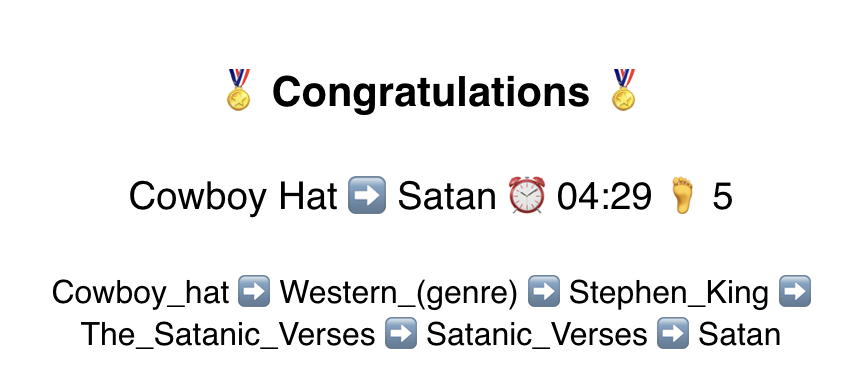Stratechery with the best DeepSeek AI explainer. It’s broad in describing the general applications and industry impacts, as well as parsing the technical bits of what they did.
Author: Patrick
-
Texas blade shop owner refuses to add Nazi symbol to knife
Texas blade shop owner refuses to add Nazi symbol to knife.
What stands out about this incident:
- how emphatic on what he would not do “I won’t re-Nazify shit.”
- offered the woman an out to “add a modern German forestry seal… de-Nazify shit.”
- how nonchalant the woman was with her request
The shop, https://www.thebladebartx.com/, is located in Edom, TX, and one of the owners, Jonathan Sibley, competed on Forged in Fire.
-
The Wiki Game
A fun way to explore Wikipedia: The Wiki Game. Click article links to navigate from one article to another. It’s timed and scored like golf.

-
A network of AI-generated newsletters targeting “small town America”
Nieman Labs reports that “a network of AI-generated newsletters targeting “small town America.” All run by one person.
It turns out Good Day Fort Collins is just one in a network of AI-generated newsletters operating in 355 cities and towns across the U.S. Not only do these hundreds of newsletters share the same exact seven testimonials, they also share the same branding, the same copy on their about pages, and the same stated mission: “to make local news more accessible and highlight extraordinary people in our community.”
We need to add AI generated awareness to the media literacy skill set.
-
Red envelopes for Lunar New Year
Here’s some good background on those red envelopes, Hongbao, shared on Lunar New Year
The modern concept of hongbao emerged in early 20th-century China. Elders would give money wrapped in red paper to children during the Lunar New Year as a talisman against evil spirits, known as sui (祟).
But the gift giving traditions go back to about 200 BCE, way before Santa flew across the world.
-
Ladies & Gentlemen…50 Years of SNL Music
If this isn’t infectious, I don’t know what is. Questlove drops a trailer for a documentary about 50 years of SNL musical guests.
-
Building a resistance to meet the 3.5% rule
Rabbi Danya Ruttenberg, at Life is Sacred, found research on non-violent resistance campaigns.
Chenoweth and Stephan even discovered something so important here that it gets a name: the 3.5 Percent Rule.
Everywhere they looked where a nonviolent resistance campaign engaged the “active and sustained participation” of at least 3.5% of that nation’s population: they won.
See also the CIA’s Simple Sabotage: A Modern Field Manual for Detecting and Rooting Out Everyday Behaviors That Undermine Your Workplace.
-
Cover roundup: Dammit by Blink 182
And it’s happened once again
I’ll turn to a friend
Someone that understands
And sees through the master plan
But everybody’s gone
And I’ve been here for too long
To face this on my own
Well, I guess this is growing up
Well, I guess this is growing upSometimes a cover takes an original in a new direction or changes the weight of a song. Dammit, by Blink 182 can turn haunting or weary.
Dead on a Sunday takes Mr. Kitty’s “After Dark” synth banger but sings “Dammit.”
It also works with country twang, here’s Alexandra Kay.
Serj T from System of a Down turning it into a ballad.
Or a one man ska band, bring horns for a lively punch.
And in 2020, an entire album of “Dammit” covers came out.
-
Do dogs watch TV? Yes, but…
From Sian Cain in The Guardian, You’ve always wondered, here’s the answer: do dogs actually watch TV?
“We watch TV for enjoyment, for emotional realism, for whatever personal preferences we have,” Mowat says. “I think dogs watch TV because they’re checking if it is real.
“There’s a reason why dogs go over and sniff the butts of the animals on the screen – they’re looking for the realism and wondering whether it’s worth paying attention to.”
Get your dog a Letterboxd account.
-
Addressing large scale problems requires large scale commitment
Mike Davidson writes about the recent Southern California fires in a post titled, 47 Years Later, The Palisades Disappeared Overnight. It tells a story of growing up in a particular time and how Los Angeles overcame its smog epidemic. Plus, his father was a unique position to contribute as a meteorologist. What eventually did it? Everyone agreed it was a problem and people went along with the solutions.
When you fly into LA today and see what you think is smog, rest assured it is nothing compared to what we had in the ’80s. The one advantage this public health problem had though is that it was in your face every day. Everyone in LA felt it daily and supported their government’s efforts to solve the problem.